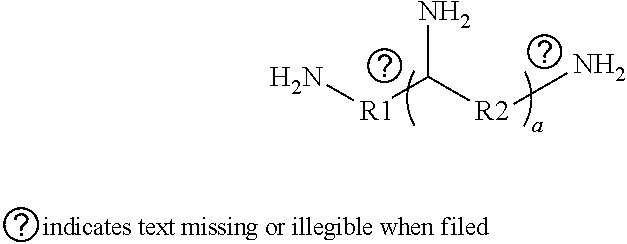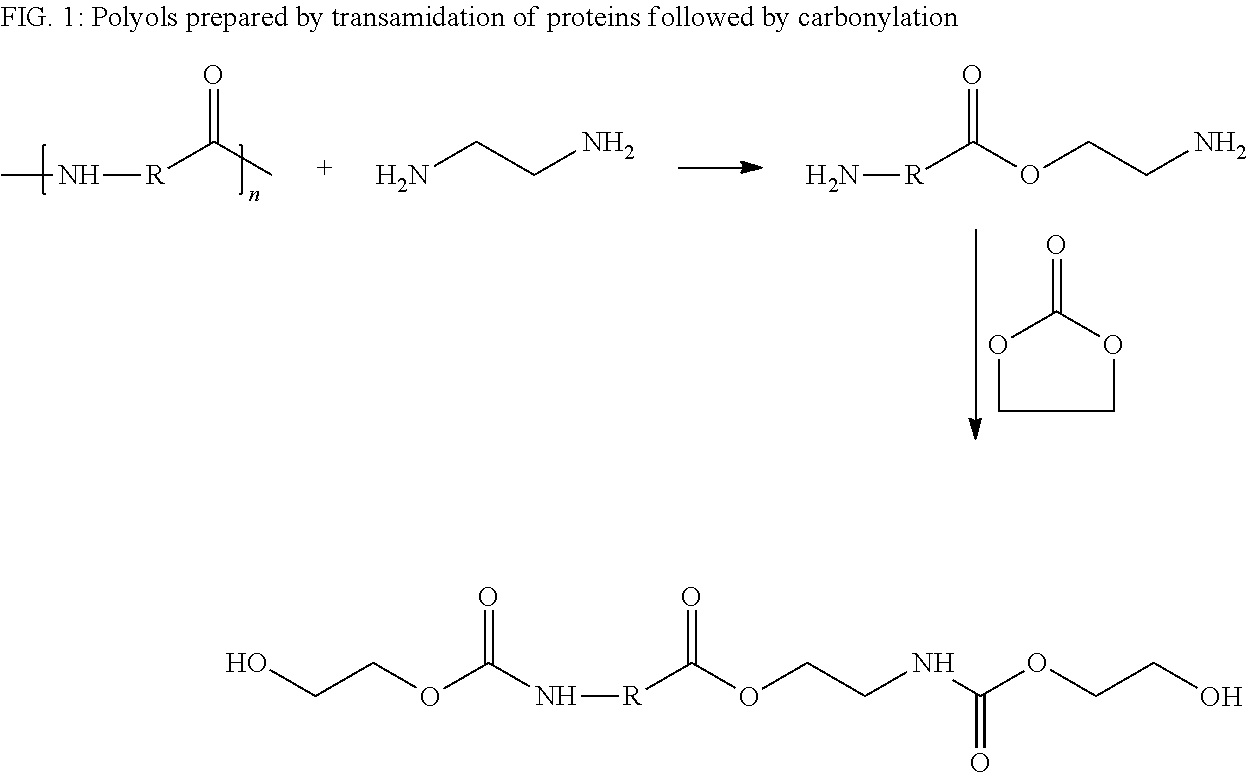Polyols from protein biomass
- Summary
- Abstract
- Description
- Claims
- Application Information
AI Technical Summary
Benefits of technology
Problems solved by technology
Method used
Image
Examples
example 1
Polyols Obtained by Transamidation of Soymeal with Ethylene Diamine
[0042]Soymeal (50 gr.) ethylene diamine (300 gr.), water (50 gr.) and boric acid (16 gr.) were added to a 2 L Paar reactor. The reactor was then flushed with nitrogen and the reaction was allowed to proceed at 150° C. for 3 hr. Excess (unreacted) ethylene amine and water were then stripped out of the reactor and the temperature was decreased to 80° C. A sample of the product intermediates was collected and was titrated to determine the amine value (375 mgKOH / gr.) so that stoichiometric amounts of ethylene carbonate can be added. Accordingly, 20 gr. of amine derivative of the soymeal intermediate was added to a 100 mL round-bottomed flask and was heated to 80° C. under an inert atmosphere.
[0043]Then, 12.8 gr. (0.15 mole) ethylene carbonate was added slowly to maintain a temperature below 90° C. After all the ethylene carbonate was added, the reaction was allowed to continue for an additional 1 hr. in order to ensure c...
example 2
Polyols Obtained by Non-Aqueous Transamidation of Soymeal with Ethylene Diamine
[0044]The same procedure as described in example 1 was repeated with no added water. Thus, Soymeal (50 gr.) ethylene diamine (300 gr.) and boric acid (16 gr.) were added to a 2 L Paar reactor. The reactor was then flushed with nitrogen and the reaction was allowed to proceed as before at 150° C. for 3 hr. Excess (unreacted) ethylene amine was stripped out of the reactor and the temperature was decreased to 80° C.
[0045]A sample of the product intermediates was collected and was titrated to determine the amine value (385 mgKOH / gr.) so stoichiometric amounts of ethylene carbonate could be added. Accordingly, 20 gr. of amine derivative of the soymeal intermediate was added to a 100 mL round-bottomed flask and was heated to 80° C. under an inert atmosphere. Then, 13.0 gr. (0.16 mole) of ethylene carbonate was slowly added to maintain a temperature below 90° C. After all the ethylene carbonate was added, the re...
example 3
Polyols Obtained by Transamidation of Soy Isolate with Ethanol Amine
[0046]Soy isolate (250 gr.), ethanolamine (670 gr.), boric acid (75 gr.) and water (250 gr.) were added to a 2 L-Paar reactor. The reactor was flushed with nitrogen and the temperature was set to 150° C. The reaction was allowed to proceed at this temperature for 6 hr. and then the temperature was allowed to cool to 50° C. Water and excess ethanol amine were stripped under vacuum (200 Pa) from the reaction mixture. A sample of the product was collected and was titrated to determine the amine value (450 mgKOH / gr.) so stoichiometric amounts of ethylene carbonate could added. Accordingly, 20 gr. of amine derivative of the soymeal intermediate was added to a 100 mL round-bottomed flask and was heated to 80° C. under an inert atmosphere. Then, 13.0 gr. (0.16 mole) ethylene carbonate was added slowly to maintain a temperature below 90° C. After all the ethylene carbonate was added, the reaction was allowed to continue for...
PUM
| Property | Measurement | Unit |
|---|---|---|
| Density | aaaaa | aaaaa |
| Molecular weight | aaaaa | aaaaa |
| Molar ratio | aaaaa | aaaaa |
Abstract
Description
Claims
Application Information
 Login to View More
Login to View More - R&D
- Intellectual Property
- Life Sciences
- Materials
- Tech Scout
- Unparalleled Data Quality
- Higher Quality Content
- 60% Fewer Hallucinations
Browse by: Latest US Patents, China's latest patents, Technical Efficacy Thesaurus, Application Domain, Technology Topic, Popular Technical Reports.
© 2025 PatSnap. All rights reserved.Legal|Privacy policy|Modern Slavery Act Transparency Statement|Sitemap|About US| Contact US: help@patsnap.com



